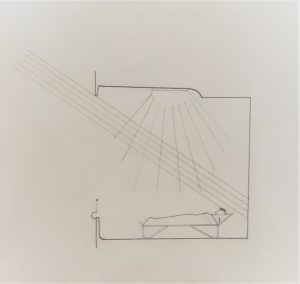Sustainability is not a new concept at all. It might be trendy hot topic, but it only reminds us of what we’ve probably forgotten. Pearls of the past is a great inspirational sourse for us – modern and a bit lost humanity. I can just wonder why do we have to learn what we already know?
Couple of weeks ago I was in Helsinki and happened to visit Alvar Aalto‘s exhibition in Ateuneum museum. As a graduate from Aalto University I had a chance to experience Aalto‘s waves in University campus through his architecture and design. So I was familiar with Aalto‘s work before going to Ateneum, but to my big surprise, only there I realized how vital Aalto‘s ideas are for these days.
Daylight is seen as a treasure in modern buildings as not every building user gets a chance to enjoy it. The reasons are many: bad architecture, bad interior design, too dense urban environment. But daylight is very important to human health. As I heard in Ecobuild last spring, human beings maintain their circadian rhythms by connecting to daylight. It means that the body follows sunlight and knows when it is supposed to produce most efficiency because the sun is at a high point. Similarly, it knows when to slow down because the sun is setting as well and it will soon be time to rest. Following this circle, the body maintains its human nature, is healthy and relaxed. And when it is „disconnected“ from daylight, it loses the healthy rhythm which results in sleeping disorders, concentration issues, chronical tiredness, etc.
When I heard about circadian rhythm studies in Ecobuild, I thought „Wow! So cool that some scientists are analysing this subject and got these amazing conclusions. Now we know how to help people be healthier“. Besides, there are lighting companies who have already created artificial lighting that follows circadian rhythms over the day. Such lighting creates „morning“, „day“ and „evening“ in the office when there isn‘t enough of natural daylight, for instance, in Nordic countries.
Very new, very modern, right? But only when I saw Aalto‘s exhibition, I realised how lost we actually are that we need to „discover“ the things that were already known years ago. Simply back then there was no need for scientific proof for each piece of knowledge which was just known as vital for us.
One of the first buildings that Aalto designed, was Paimio Sanatorium (Paimion parantola) in 1933. Aalto designed it so that each room would have large windows, and therefore sufficient daylight, as well as great views to the nature.
Aalto’s design was based on knowledge that patient’s recovery is faster when he/she can connect with the nature. When patient can follow natural daytime and observe living creatures outside of the hospital. Aalto designed that building for people. A quite from exhibition:
“Sanatorium wings face the sun, analogous to the natural orientation of plants because prior to discovery of antibiotics, light, fresh air, sunshine, good hygine and rest were the most effective treatments. Aalto also outfitted the patients’ rooms with their needs and the healing process in mind: glare-free lighting, acoustically insulated walls, soundabsorbing sinks and muted colours.”
Don‘t you think that buildings should always be designed and built for people? Whom else for would hospitals, schools and apartment houses be built for?
As a genuine architect, Aalto knew that buildings should bring value for people who use them. He designed for people, in connection to nature. Therefore, we, modern people, do not have to connect with the nature. We‘d rather not lose that fundamental connection in the first place. I wish all the buildings nowadays were designed keeping that principle in mind… There wouldn‘t be much to „learn“ or „discover“ if we haven‘t forgotten what was already known in the past, if connection with our true selves hadn‘t been lost.
When and how people got disconnected, I don‘t know. I was born in era where Sustainability took place, and am sincerely surprised to find that those green concepts we follow nowadays existed many years ago. Without scientific proves, without technologies, without business cases. Simply developed by people who had connection with the nature and true selves.




